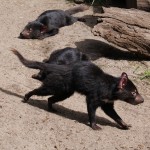Most of my early science and nature stories were originally published on the website Science Network WA which the owner, Scitech, has retired. Many were republished by Phys.org and you can view them if you click here.
Science Network had an agreement with Seven West Media to republish some of its stories in The West Australian, The Broome Advertiser and other regionals.
2013
In 2013 I wrote three of the publication’s 10 most read articles.
Survey reveals rich mineral fault lines
THE Geological Survey of Western Australia has confirmed that the remains of a small continent, about the size of Japan, is embedded in central Western Australia.
Geologist Simon Johnson says the Glenburgh Terrane, which includes Glenburgh Station near Gascoyne Junction, was trapped between tectonic plates two billion years ago.
He says the Pilbara and Yilgarn Cratons are the remains of tectonic plates that collided, forcing each others’ edges up to form mighty mountain ranges.
These have slowly eroded down to become the Capricorn Orogen.
This was The Science Network’s second-most read story for 2013 [read this story].
Research debunks Great White lineage
Two million years ago, the Metatooth shark dominated the oceans.
It measured up to 18 metres from snout to tail.
A THOROUGH re-examination of fossil collections shows the modern Great White shark is not closely related to the extinct “Megatooth” shark as was previously believed.
WA Museum paleontologist Dr Mikael Siversson says both sharks were thought to have evolved from a Cretaceous species Cretalamna appendiculata, but reclassification has overturned this assumption.
“There is little to suggest that Cretalamna had anything to do with the origin of the White Shark,” Dr Siversson says.
“But there seems to be a clear link between Cretalamna and the lineage that eventually produced the giant megladon shark.”
He says Cretalamna and the Great White have a common ancestor that lived 110–120 million years ago.
This was The Science Network’s third-most read story for 2013. Science Network [read this story]
Geological exploration reveals Australian super volcano
A geological survey team says an ancient super volcano exuded more than 450 cubic kilometres of molten magma in a single eruption, over what are now Ngaanyatjarra tribal lands.
Geochemist Dr Hugh Smithies says it is the largest super volcano he is aware of on the planet.
He says the eruption occurred at the point where three tectonic plates converged.
This was The Science Network’s seventh-most read story for 2013 – also republished in The West Australian 2/10/2013 [read this story]
Archaeology at Barrow Island
Barrow Island, off the WA coast, was once part of the mainland. As sea levels rose, the Aboriginal inhabitants would have visited less and less often. It is likely that they didn’t go there at all for some 7,000 years, until the pearling industry brought a few people back to the island in the 19th Century.
Archaeologists are about to start excavating several ancient habitation sites. This should give us a rare glimpse of what life was like in the ice age.
Science Network [read this story]
2012
Burning the bush helps conserve animals and plants
STANFORD University researchers have produced hard data to show desert Aboriginal bush-burning practices result in smaller, cooler fires and help conserve reptiles and small mammals while promoting plant diversity. Science Network WA [read this story]
Tasmanian Devils on the mainland
In a couple of articles I have explored the possibility of Tasmanian Devils being introduced back into the wild – in mainland Australia. Click here to read more.
2011
Groundwater management for the Ord
The government has insisted on stringent environmental management plans prior to the expansion of the Ord River Irrigation scheme.
Science Network WA [click here] to read more.

